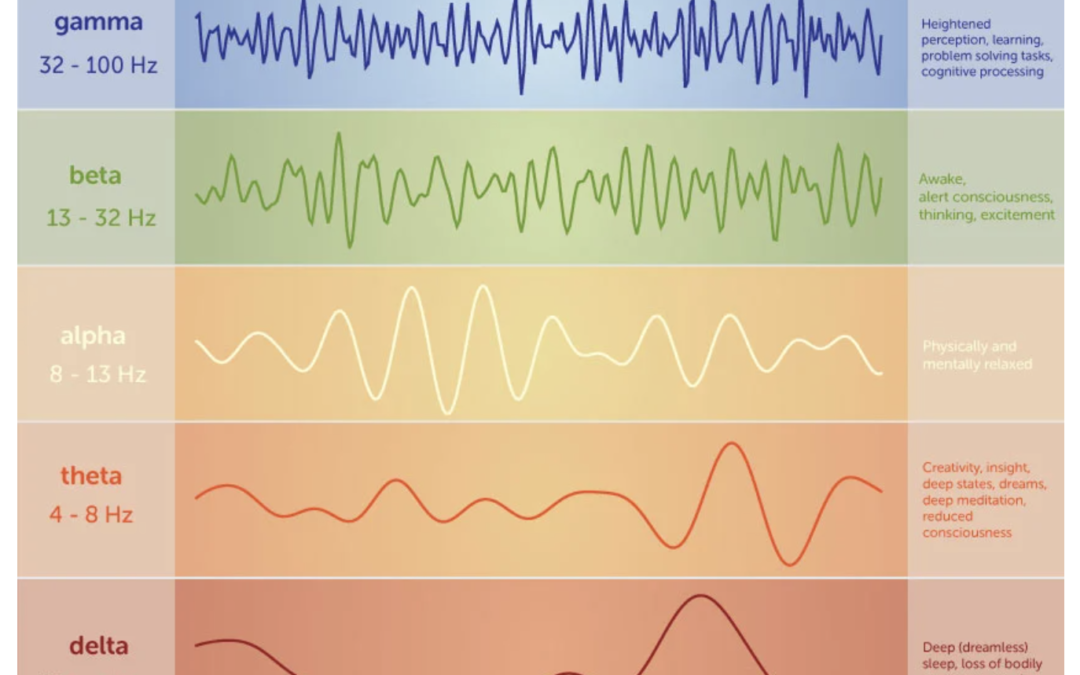Measurable, “Real” Relaxation
Massage therapy, while assisting to create a relaxed state, actually alters one’s state of consciousness. The brain emits small electrical charges which can be measured by an electroencephalograph or EEG. These impulses are categorized by their frequencies or wave patterns and tell us about our state of mind:
-
Beta – oscillating at the highest frequencies (14 to 38 cycles per second), beta waves occur when we are most active and engaged: problem solving, multi-tasking, organizing, conversing and active thinking.
-
Alpha – (8 to 13 cycles per second) these waves happen when we are calm and relaxed, yet focused. Staying in this meditative yet alert state takes practice in our hectic, stressful world.
-
Theta – (4 to 7 cps) during a massage, when you begin to sense the music is distant and your awareness drifts, this is known as the theta state. Most mind/body connections occur here and it is believed to be the still point where most healing happens on a deep, cellular level.
-
Delta – (0.1 to 4 cycles per second) this is deep space for the mind — all sensations in the physical realm are ignored unless triggered by what is considered important by one’s consciousness: alarms, a voice calling you back or a child crying.
Clients often arrive in the beta state, but with soothing touch and a warm, comfortable environment, any of the lower-frequency states can be achieved. Occasionally, someone will apologize for falling asleep or snoring. No worries! Relaxation is one of the goals of your visit….and you still get all the other benefits massage offers.
Rod Cain, LMT owns and operates Rod Cain Massage Therapy in Burlington, Vermont.

The 5 main types of brainwave frequencies
Different patterns of brainwaves can be recognized by their amplitudes and frequencies. Brainwaves can then be categorized based on their level of activity or frequency. It’s important to remember, though, that brainwaves are not the source or the cause of brain states, or of our experiences of our own minds – they’re just some of the detectable reflections of the complex processes in the brain that produce our experience of being, thinking, and perceiving.
- Slow activity refers to a lower frequency and high amplitude (the distance between two peaks of a wave). These oscillations are often much larger in amplitude (wave depth). Think: low, the deep beat of a drum.
- Fast activity refers to a higher frequency and often smaller amplitude. Think: high pitched flute.
Below are five often-described brainwaves, from the fastest activity levels to the slowest.
Gamma Brainwaves
- Frequency: 32 – 100 Hz
- Associated state: Heightened perception, learning, problem-solving tasks
Gamma brainwaves are the fastest measurable EEG brainwaves and have been equated to ‘heightened perception’, or a ‘peak mental state’ when there is simultaneous processing of information from different parts of the brain. Gamma brainwaves have been observed to be much stronger and more regularly observed in very long-term meditators including Buddhist Monks.
Beta Brainwaves
- Frequency: 13-32 Hz
- State: Alert, normal alert consciousness, active thinking
For example:
- Active conversation
- Making decisions
- Solving a problem
- Focusing on a task
- Learning a new concept
Beta brainwaves are easiest to detect when we’re busy thinking actively.
Alpha Brainwaves
- Frequency: 8-13 Hz
- State: Physically and mentally relaxed
Alpha brainwaves are some of the most easily observed and were the first to be discovered. They become detectable when the eyes are closed and the mind is relaxed. They can also often be found during activities such as:
- Yoga
- Just before falling asleep
- Being creative and artistic
Theta Brainwaves
- Frequency: 4-8 Hz
- State: Creativity, insight, dreams, reduced consciousness
According to Professor Jim Lagopoulos of Sydney University, “previous studies have shown that theta waves indicate deep relaxation and occur more frequently in highly experienced meditation practitioners. The source is probably frontal parts of the brain, which are associated with monitoring of other mental processes.”
Most frequently, theta brainwaves are strongly detectable when we’re dreaming in our sleep (think, the movie Inception), but they can also be seen during :
- Deep meditation
- Daydreaming
When we’re doing a task that is so automatic that the mind can disengage from it e.g. brushing teeth, showering. Research has also shown a positive association of theta waves with memory, creativity, and psychological well-being. (5) (6)
Delta Brainwaves
- Frequency: 0.5-4 Hz
- State: Sleep, dreaming
These are the slowest of all brainwaves and are strongest when we are enjoying restorative sleep in a dreamless state. This is also the state where healing and rejuvenation are stimulated, which is why it’s so crucial to get enough sleep each night.
How to train your brainwaves
Is it possible to change how much we experience these different brainwaves, and the brain states and thought experiences associated with them? In short, yes.
Conditioning and Neurofeedback
For decades, practitioners have engaged in training programs which are intended to reinforce the brain states which produce increases in certain brain oscillations and decreases in others. The most common example of this, called neurofeedback, can utilize EEG or other brain-sensing modalities.
Neurofeedback practitioners and clinicians find that immediate, direct feedback on brain states, whether in the form of sound, light or even a video game, can produce changes in underlying behaviors and brain states that are reflected in brainwaves. This feedback seems to accelerate the learning process, by making brain states more apparent to the recipient.
Another important discovery in the recent history of neuroscience is the significant differences in brainwave characteristics of highly experienced meditators. Expert meditators not only have different resting-state brainwaves from non-meditators – but they also seem able to control their brainwaves through voluntary thought control with greater ease than others.
So how do we start to improve our ability to control our brainwaves? These brainwave-changing skills can be learned. Meditation deepens your ability to focus and control your attention.
Article from: https://choosemuse.com/blog/a-deep-dive-into-brainwaves-brainwave-frequencies-explained-2

